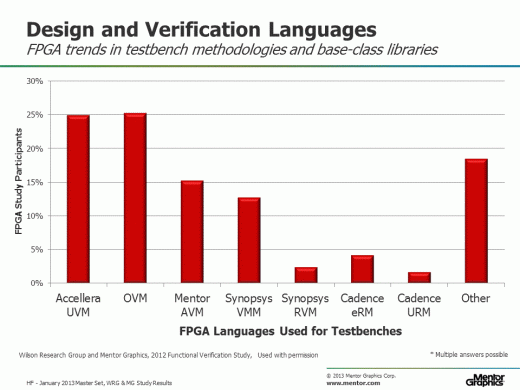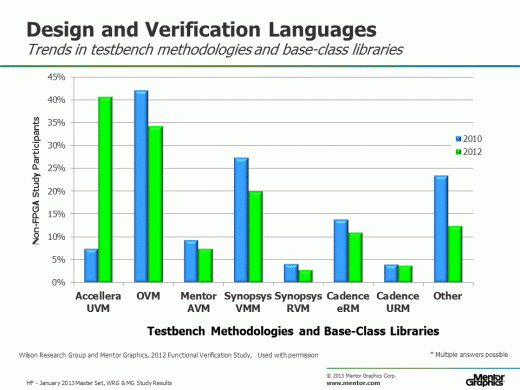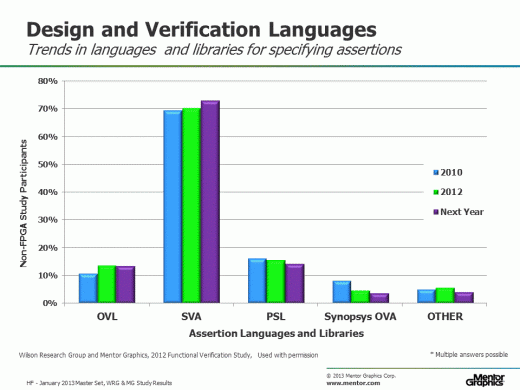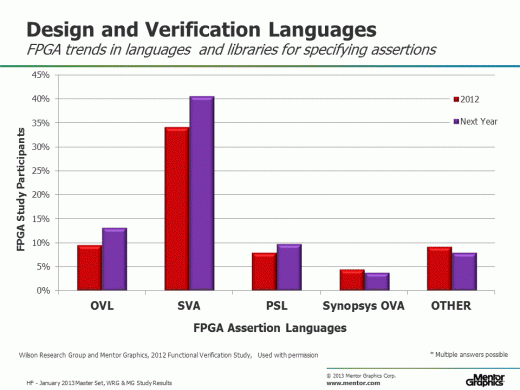Part 9: The 2012 Wilson Research Group Functional Verification Study
Language and Library Trends (Continued)
This blog is a continuation of a series of blogs that present the highlights from the 2012 Wilson Research Group Functional Verification Study (for a background on the study, click here).
In my previous blog (Part 8 click here), I focused on design and verification language trends, as identified by the Wilson Research Group study. This blog presents additional trends related to verification language and library adoption trends.
You might note that for some of the language and library data I present, the percentage sums to more than 100 percent. The reason for this is that some participants’ projects use multiple languages or multiple testbench methodologies.
Testbench Methodology Class Library Adoption
Now let’s look at testbench methodology and class library adoption for IC/ASIC designs. Figure 1 shows the trends in terms of methodology and class library adoption by comparing the 2010 Wilson Research Group study (in blue) with the 2012 study (in green). Today, we see a downward trend in terms of adoption of all testbench methodologies and class libraries with the exception of UVM, which has increased by 486 percent since the fall of 2010. The study participants were also asked what they plan to use within the next 12 months, and based on the responses, UVM is projected to increase an additional 46 percent.
Figure 1. Methodology and class library trends
Figure 2 show the adoption of testbench methodologies and class libraries for FPGA designs (in red). We do not have sufficient data to show prior adoption trends in the FPGA space, but we anticipate that our future studies will enable us to do this. However, we did ask the FPGA study participants which testbench methodologies and class libraries they were planning to adopt within the next 12 months. Based on these responses, we anticipate that UVM adoption will increase by 40 percent, and OVM increase by 24 percent in the FPGA space.
 Figure 2. Methodology and class library trends
Figure 2. Methodology and class library trends
Assertion Languages and Libraries
Finally, let’s examine assertion language and library adoption for IC/ASIC designs. The Wilson Research Group study found that 63 percent of all the IC/ASIC participants have adopted assertion-based verification (ABV) as part of their verification strategy. The data presented in this section shows the assertion language and library adoption trend related to those participants who have adopted ABV.
Figure 3 shows the trends in terms of assertion language and library adoption by comparing the 2010 Wilson Research Group study (in blue), the 2012 Wilson Research Group study (in green), and the projected adoption trends within the next 12 months (in purple). The adoption of SVA continues to increase, while other assertion languages and libraries either remain flat or decline.
Figure 3. Assertion language and library adoption for Non-FPGA designs
Figure 4 shows the adoption of assertion language trends for FPGA designs (in red). Again, we do not have sufficient data to show prior adoption trends in the FPGA space, but we anticipate that our future studies will enable us to do this. We did ask the FPGA study participants which assertion languages and libraries they planned to adopt within the next 12 months. Based on these responses, we anticipate an increase in adoption for OVL, SVA, and PSL in the FPGA space within the next 12 months.
Figure 4. Trends in assertion language and library adoption for FPGA designs
In my next blog (click here), I plan to focus on the adoption of various verification technologies and techniques used in the industry, as identified by the 2012 Wilson Research Group study.
Comments
Leave a Reply
You must be logged in to post a comment.






Figure #1 is the big story! UVM usage has increased by 486% in just the past two years. Every other verification methodology, including the previous leader, OVM, is seeing moderate to sharp declines. This is good new for end users and the verification community. We finally have a powerful winner in the verification methodology space.
You need a way for readers, like myself, to easily share this information using my Sunburst Design Facebook page or by way of LinkedIn. Please add “Share” buttons.
Hi Cliff. Be careful about interpreting the results. In 2010, UVM was not even officially a standard. Only an early adopter kit was out from Accellera. Nonetheless, to have 41 percent industry adoption within the last two years, and a projected growth of 40 percent adoption within the next year is pretty impressive considering it is a new standard.
Concerning the “share” option, I’ll pass your suggestion on to IT…. In the mean time, you might want to use this short link as a reference:
http://go.mentor.com/365l_
Hi Cliff, I just found out that a share button is already available for you to use. If you look up at the top of this blog, you will see a pretty picture of me. Right under my picture is an orange plus sign that says Share. I never noticed that myself!!!!